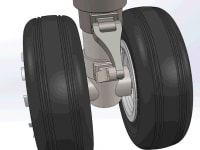More than 80,000 aircraft take off and land daily in the world: more than one every second. Airlines are thus losing a daily average of $6.5 million due to the wear and tear of tires during landing. This wear and tear is illustrated by smoke and dark marks on the runway and is due to the brutal acceleration of tires when touching the ground. To reduce this loss of material, a solution is to rotate the wheels before touch down. Multiple solutions such as putting engines on the wheels or installing small wings on the rims have been proposed in the past. However, none appeared to be economically viable due to a lack of technological know-how. Recent technological improvements and new materials such as Titanium Matrix Composite now allow us to develop a system that pre-rotates the wheels using only aerodynamic forces. The installation of small wing profiles on the wheels would transform aerodynamic energy into mechanical energy that can be transferred to the wheels. With a revolutionary design combined with a new alloy, those rims would not increase the wheel weight and thus the operating cost. Calculations have demonstrated that around 50% of the tires’ wear and tear can be avoided using this system. This would help airlines save more than $1 billion a year. In addition, this system can be easily implemented on new aircraft as well as retrofitted on existing aircraft. This would also help reduce the aviation’s global environmental footprint through less waste of rubber and runway cleaning products.
Video
Like this entry?
-
About the Entrant
- Name:Christopher Frank
- Type of entry:teamTeam members:Mathilde Deveraux - Georgia Institute of Technology Christopher Frank - Georgia Institute of Technology
- Patent status:none








